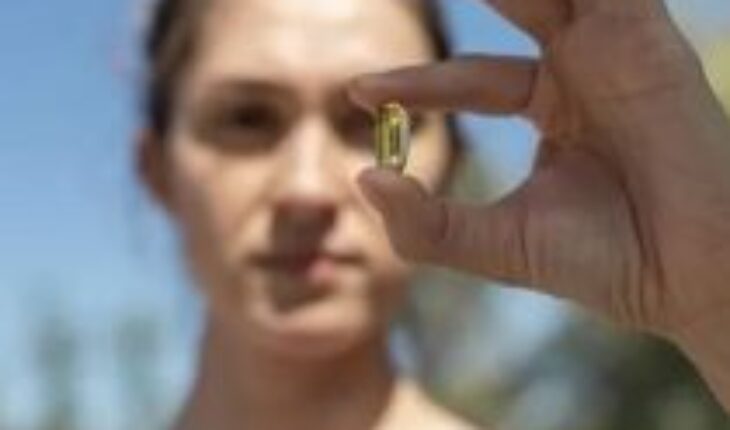The vitamin d It has been a source of interest for years due to its benefits for the immune system of our body and its importance for the health of our bones.
But since the covid-19 pandemic it has also become an element of controversy given the spread of content on the internet that mentions it as a key factor in our body’s fight against the disease.
Although it must be said that the role of vitamin D in the fight against the coronavirus is still being investigated by scientists and there is no consensus, it is notorious that the considerable increase in people who lack adequate levels of this vitamin in recent years arises just after the period in which we were forced to confine ourselves to our homes by the pandemic.
Hence, since then, sales of so-called supplements have skyrocketed. “Sunshine Vitamin” in many parts of the world.
However, many experts warn that its excessive intake can be counterproductive.
Faced with so much information and misinformation we decided to find out with the help of specialists and scientific articles who are the people who should take the supplements, what diseases can be prevented and what would be an ideal level in the blood.
Let’s start with what is already known about vitamin D.
Basics
The first thing to note is that, despite its name, vitamin D is not a vitamin but a hormone.
When it was discovered more than a century ago, by a team led by the American biochemist Elmer McCollum, it was thought that it was a vitamin to which it was identified with the letter D.
Vitamin D, which is actually a hormone, was discovered in 1922. GETTY IMAGES
Decades later, with new research and the detail of its molecular structure, it was determined that it was a hormone.
Among its properties it has been shown that Regulates the amount of calcium and phosphorus in the body, and these are essential for the growth and maintenance of bones, teeth and muscles. In other words, vitamin D is very important for bone and muscle health.
We also know that it can be obtained in three ways: through our body’s own production thanks to the sun exposure, through foods (in particular oily or fatty fish) and by supplements.
With any of these three sources you can achieve the adequate level of vitamin D that the body needs, although many variables must be taken into account to know if we are doing it correctly.
A light-skinned person does not react the same to a person with darker skin and the impact of the sun’s rays is not the same at the equator as in temperate zones.
There is also “a lack of nutritional education to understand that food will hardly be enough to meet the need,” nutritionist Marcela Mendes told BBC News Brazil.
“The main foods with vitamin D are wild salmon, mushrooms and oily fish. What is the real application of this in our population? The intake (of these foods) would have to be daily for us to really have a source,” said Mendes, PhD in Nutritional Sciences from the University of Surrey (England) and member of the vitamin D research group of the Universities Global Partnership Network (UGPN).
Global data collected in an article in the journal Nature show that the percentage of vitamin D deficiency in the population in the United States reaches 24%, while in Canada it reaches up to 37% and in Europe to 40%.
It is believed that the percentage in Latin America is considerably lower given the constant exposure to the sun that usually occurs most of the year in the region, but that does not mean that it is completely exempt from the problem.
In one of the few studies conducted on the subject in November 2022 in Brazil for the Journal of the Endocrine Society From Oxford University, endocrinologist Marise Lazaretti-Castro found vitamin D deficiency in 12.1% of people in Salvador, 20.5% in São Paulo and 12.7% in Curitiba.
One of the causes, they mention, is due to the current lifestyle that causes sun exposure to be reduced, since we stay longer at home and use sun protection.
To counteract this trend, the consumption of supplements is recommended, but not in all cases and always in moderation.
Vitamin D can be obtained through sun exposure, supplements, and foodmentation. GETTY IMAGES
The first thing that is necessary is to check the levels of the hormone circulating in the body and so a doctor or nutritionist can decide if supplements are necessary or not.
Although it can vary depending on the characteristics of each one, the level of vitamin D that a person should have ranges between 50 and 250 nanomoles per liter.
To maintain this level, adolescents and adults need about 15 micrograms a day or 600 IU (international unit established by the Biological Standardization Committee of the World Health Organization).
Nutritionist Marcela Mendes says she perceives, by the population and some health professionals, the use of vitamin D as something “miraculous”.
“It’s important to note that supplements are a very important strategy — there are many situations where a supplement is needed and it’s the supplement that’s going to solve the problem,” Mendes said.
“But today, we see people taking 5,000, 10,000 IU a day expecting the molecule to perform some specific action,” he added.
One of the dilemmas that arise is to recommend exposure to the sun but at the same time protect yourself from it. GETTY IMAGES
For Dr. Marise Lazaretti-Castro, an overdose carries risks.
“In the long term, it will lead to vitamin D poisoning, which is serious. Calcium rises a lot in the blood and that gives many adverse effects, such as nausea, vomiting, diarrhea. It can also give loss of appetite, weight loss, polyuria, dehydration, kidney failure, loss of kidney function … Death may even occur.”
“Vitamin D deficiency is bad, but so is excess,” he warns.
Role of the vitamin in the prevention and treatment of diseases
Although the benefits of vitamin D for bone health are already known, the so-called “extraskeletal effects” of the hormone are being studied, and in full swing.
Only in the first quarter of this year have scientific articles been published investigating the role of vitamin D in multiple sclerosis, dementia, asthma, melanoma skin cancer and many other diseases.
The hypothesis that the hormone may have a role in the prevention or treatment of disease is due, in part, to the fact that vitamin D receptor genes have been found in several types of cells in the human body, from neurons to lymphocytes. That is, if there are receptors, vitamin D is likely to play some role in that cell.
In addition, studies with guinea pigs in which these receptors were excluded showed that the mammary glands became more prone to breast cancer; the heart muscle, to hypertrophy; the prostate, to hyperplasia; and the liver, to gain weight.
However, there are questions about whether the link between vitamin D and health effects is one of causation, correlation or even “reverse causation,” according to endocrinologist Marise Lazaretti-Castro.
“Because vitamin D depends on sun exposure, if you’re sick, you won’t get as much sun exposure. It’s what we call reverse causation: the disease is producing the least amount of vitamin D, not the other way around,” he says.
According to doctors, there are still many things to discover about the benefits of vitamin D. GETTY IMAGES
In order to demonstrate the causality between vitamin D and some effect on health, it would be best with studies through randomized controlled clinical trials, which consist of tests with volunteers.
But even the largest study of its kind, VITAL, in the United States, ran into obstacles.
It investigated the relationship between vitamin D, cancer and cardiovascular disease through a follow-up of 25,817 volunteers for an average of five years.
They were divided into a group that received supplements with a high dose of vitamin D (2,000 IU) and another that received a placebo.
The study concluded that vitamin D did not produce a significant reduction in the risk of cancer or cardiovascular disease. Deaths from cardiovascular disease were also not reduced, but in the case of cancer, the reduction in mortality was 17%.
But Lazaretti-Castro explains that the VITAL study faced a hurdle that vitamin D clinical trials often encounter: It’s unethical to leave the group of volunteers receiving placebo deficient in the hormone.
There is currently a wide range of vitamin D supplements that can be purchased without the need for a prescription. GETTY IMAGES
So the American experiment allowed all volunteers, whether or not they were in the control group, to take 800 IU daily of supplements, which is a good amount.
The difference in the The group that received the high doses is that these people received even more vitamin D.
The endocrinologist has also participated in four editions of a conference dedicated to the controversies around the hormone where it is debated from the ideal reference values of vitamin D in the blood to from what amount a high dose of vitamin D presents health risks.
“There is consensus on two points: 25-hydroxyvitamin D levels below 12 ng/mL are clearly deficient at all ages and levels above 30 ng/mL are clearly sufficient. On the other hand, there is disagreement on how to classify levels between 12 and 30 ng / mL, “says a text with the conclusions of the III International Conference on Vitamin D Controversies, held in 2019.
For Marcela Mendes, the main certainty that remains is that “we know that the future path of vitamin D is to discover much of its importance.”
* Based on a text by Mariana Alvim, BBC News Brazil





